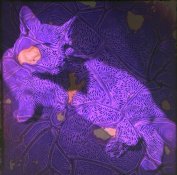Too Many Cameras
Member

I've been digitizing some slides, negatives, and plates that were loaned to me. They span from the early 19-teens to 1966. This is from around August 1942, based on the rest of the slides in the box. This is a 4X4 slide on probably Kodakchrome (that seemed to be the photographer's film of choice.) So far none of these other slides in this or the other boxes have exhibited this odd coloration or strange pattern.
The slides had been kept in a photo lab closet for the last 30 years, before that who knows. Most of them are sandwiched between two glass plates and taped on all sides. (It's a pain to get these in and out of my slide copier when I digitize them with my DSLR...) Anyway, and ideas on if this is a processing error, storage issue, or something else?










